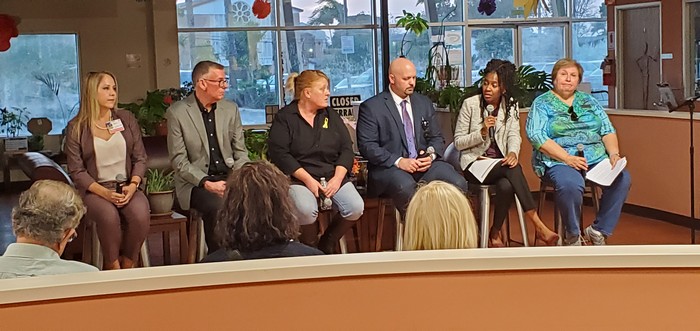
by Jill Forman
Every year in Ventura County, nearly 93 people die as a result of suicide. The World Health Organization has designated Suicide Prevention as its theme for2019. Turning Point Foundation hosted a community townhall with a panel of Ventura County mental health professionals. Their goal was to gather insight and ideas on suicide prevention across Ventura County
Attendees were a mix of medical and mental health personnel, social workers, family members affected by suicide or attempted suicide, and other involved citizens. Supervisor John Zaragoza, whose life has been impacted by such an event, came by and gave a brief but heartfelt speech.
The panel members were:
Marie Linauro (moderator) – Turning Point Foundation
Roberta Griego – NAMI (National Association for the Mentally Ill)
Dr. Sevet Johnson – Ventura County Behavioral Health
Jason Meek – Turning Point Foundation
Christine Ray – parent and advocate
Mark Schumacher – Turning Point
Dr. Pilar Sumalpong – Vista del Mar
All these dedicated and articulate experts had insights into the problem of suicide and what can be done to prevent it. Here are basic elements that were stated over and over as vital foundations of any programs.
Communication: Don’t be afraid to talk about the subject, to admit that it’s real and can happen in any family. It is a scary subject; admit that and talk about it anyway. Share stories. The only way to decrease the stigma and shame is to be open about it. With a person in danger, admit that it’s an option, let them steer the conversation and talk about it. Be a true friend and listen, validate their viewpoint.
Education: Know the signs when someone is in danger, perhaps increased stressors, and statements of hopelessness, “This is too hard.” This education needs to be started in school, at young ages. Know the risk factors, especially with trauma. “An educated community is a healthier one,” emphasized one panel member. Professionals as well as community members can come together to learn, to hear where someone in danger can be referred. Major life transition can be a danger point; someone coming out of the military, or jail, or mental health is at risk if they are not helped to merge into “normal” life. Other danger points are death of a spouse or family member, job loss, financial difficulties, health issues, divorce and anything that radically changes someone’s life.
Change In Public Attitude: Suicide has to be made a safe and palatable topic. The difficulty is that unless it has occurred in a family or circle, people don’t “get it.” It needs to be discussed with compassion and empathy, not dismissed as “weak” or “selfish.” It is not a shameful act. One panel member told about his mother being so ashamed of her husband’s suicide that she moved out of the area so she’d be where nobody knew. What a terrible thing, that she felt she had to cut herself off from everyone she knew. These were the people that could have been supporting her, in a different scenario. The stigma comes from fear that it could happen to someone we know, so we distance ourselves from even the thought of even that possibility.
Accessibility: Help has to be available to all, and affordable. The person in danger needs to be guided to services, to be reassured they are not a failure, that they are doing the best they can. As one panel member said, “Show them they’re worth it!”
Interagency collaboration is the key to successful programs. Public Health, schools, Behavioral Health, and law enforcement are all necessary components and need to coordinate their efforts. As the agenda for the meeting said, “With awareness, commitment and action we can save lives. Together.”
